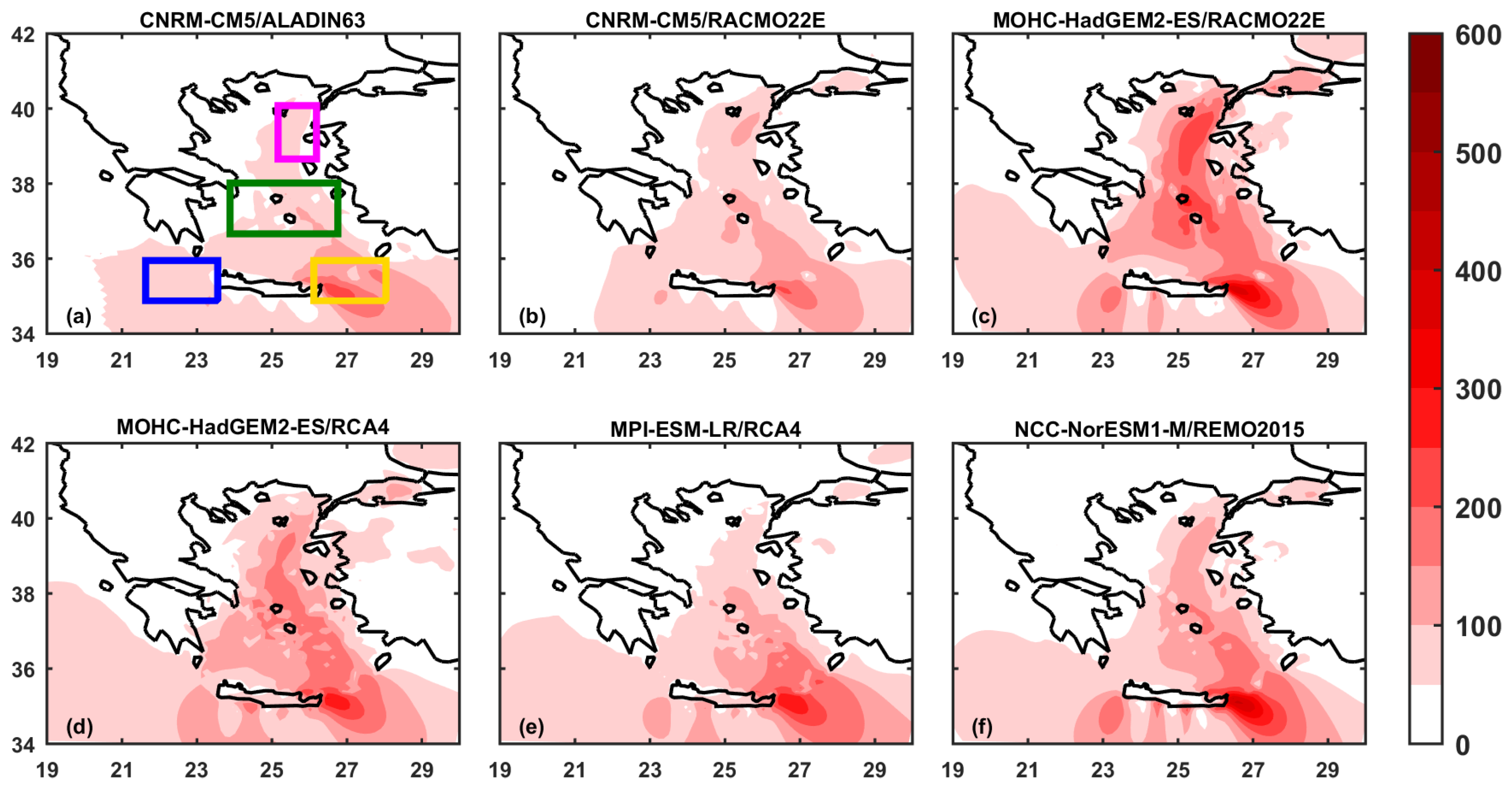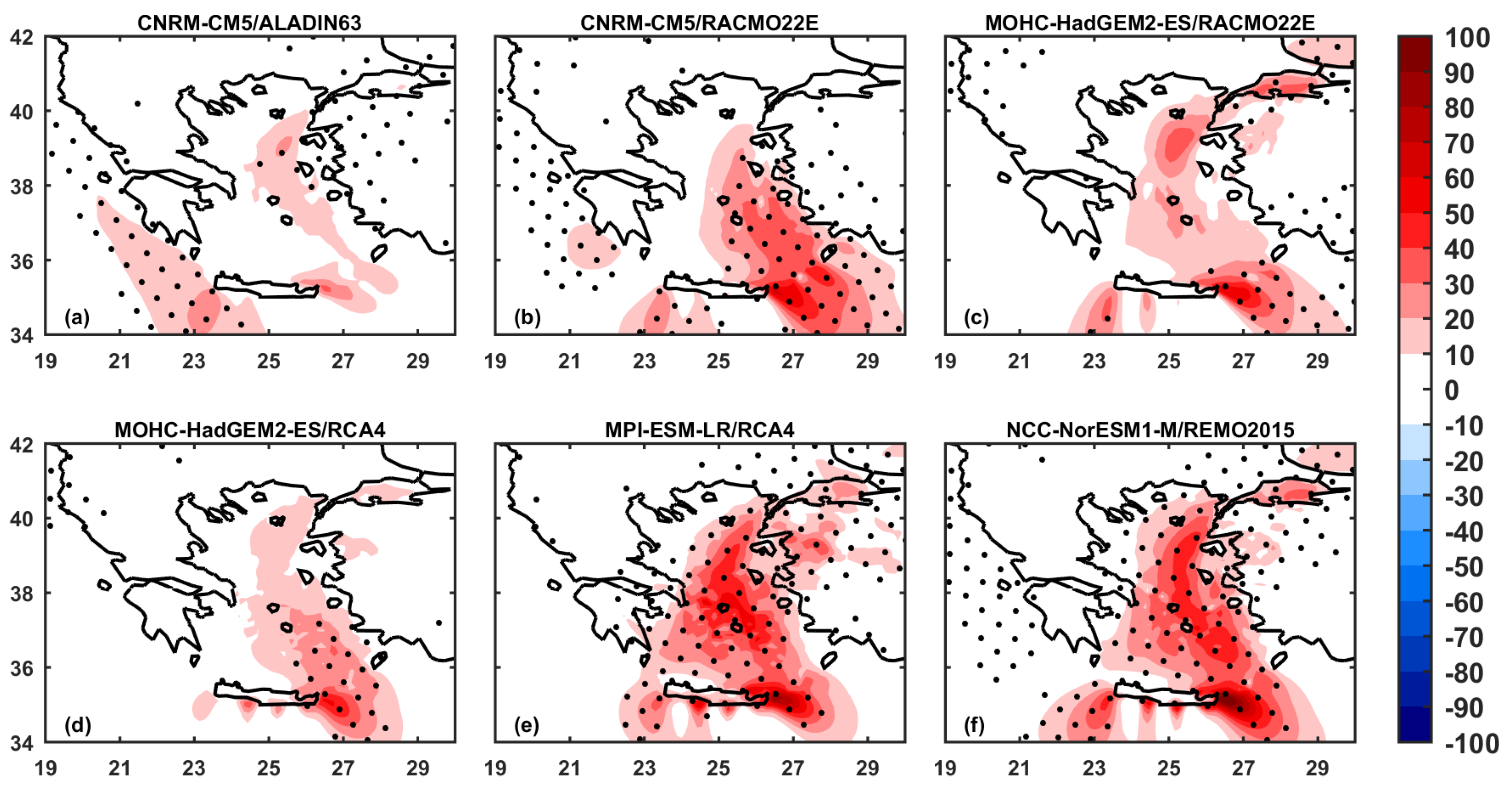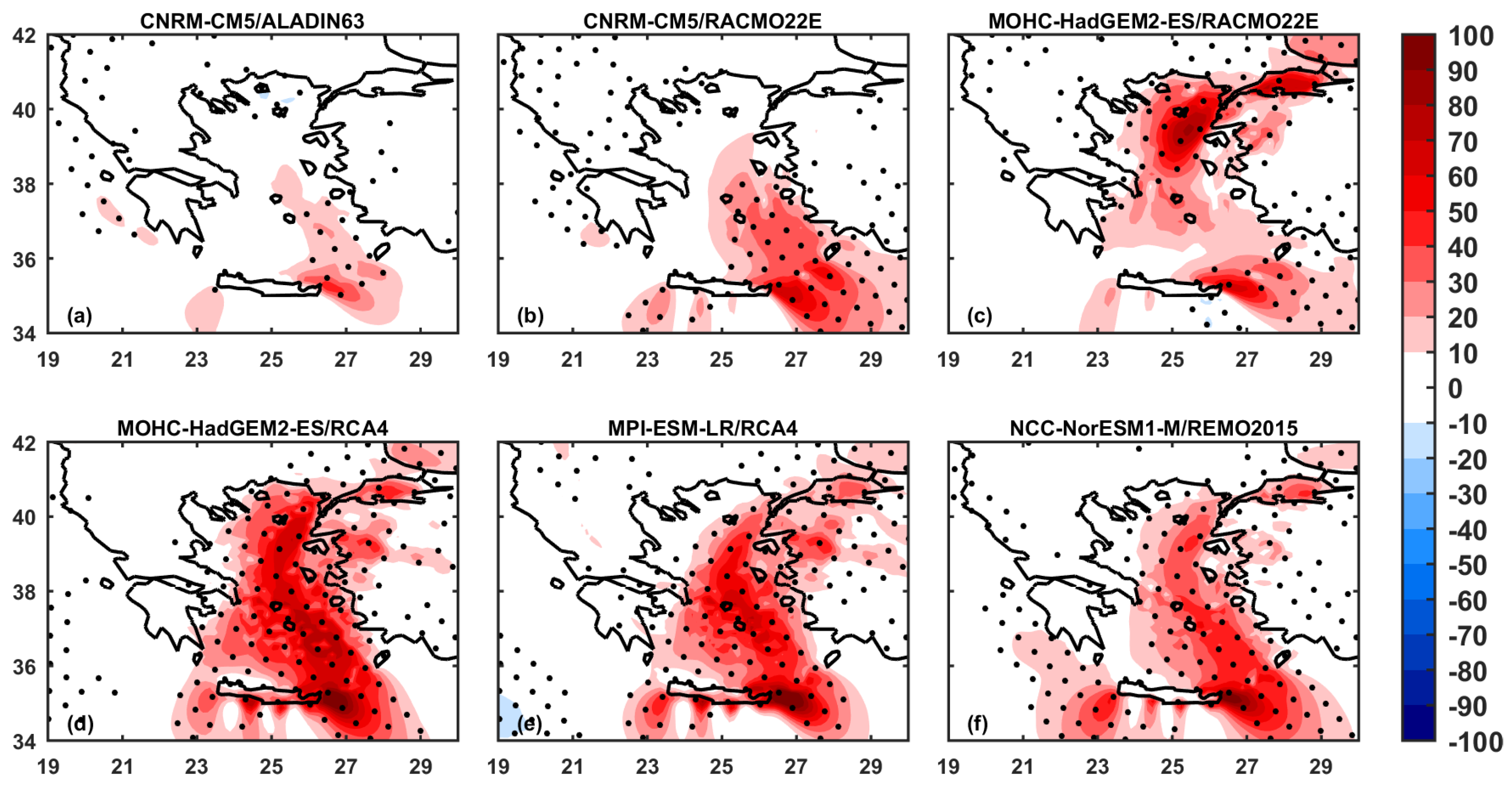Projected Changes in Wind Power Potential over a Vulnerable Eastern Mediterranean Area Using EURO-CORDEX RCMs According to rcp4.5 and rcp8.5 Scenarios †
Abstract
1. Introduction
2. Materials and Methods
3. Results
3.1. Mean WEP During the Period from 1970 to 2005
3.2. WEP Projected Changes
4. Discussion
5. Conclusions
Author Contributions
Funding
Institutional Review Board Statement
Informed Consent Statement
Data Availability Statement
Acknowledgments
Conflicts of Interest
References
- Osman, A.I.; Chen, L.; Yang, M.; Msigwa, G.; Farghali, M.; Fawzy, S.; Rooney, D.W.; Yap, P.-S. Cost, environmental impact, and resilience of renewable energy under a changing climate: A review. Environ. Chem. Lett. 2023, 21, 741–764. [Google Scholar] [CrossRef]
- United Nations—Climate Actions. Available online: https://www.un.org/en/climatechange/raising-ambition/renewable-energy (accessed on 17 September 2024).
- Mohammadia, K.; Alavib, O.; Mostafaeipourc, A.; Goudarzid, N.; Jalilvand, M. Assessing different parameters estimation methods of Weibull distribution to compute wind power density. Energy Convers. Manag. 2016, 108, 322–335. [Google Scholar] [CrossRef]
- European Commission—Energy, Climate Change, Environment. Available online: https://energy.ec.europa.eu/topics/renewable-energy_en (accessed on 19 September 2024).
- Wolf, S.; Teitge, J.; Mielke, J.; Schütze, F.; Jaeger, C. The European Green Deal—More Than Climate Neutrality. Intereconomics 2021, 56, 99–107. [Google Scholar] [CrossRef]
- European Commission—EU Regional and Urban Development. Available online: https://ec.europa.eu/regional_policy/policy/communities-and-networks/s3-community-of-practice/about_en (accessed on 15 September 2024).
- Giorgi, F. Climate change hot-spots. Geophys. Res. Lett. 2006, 33, L08707. [Google Scholar] [CrossRef]
- Cos, J.; Doblas-Reyes, F.; Jury, M.; Marcos, R.; Bretonnière, P.-A.; Samsó, M. The Mediterranean climate change hotspot in the CMIP5 and CMIP6 projections. Earth Syst. Dynam. 2022, 13, 321–340. [Google Scholar] [CrossRef]
- Logothetis, I.; Tourpali, K.; Melas, D. Projected Changes in Etesians Regime over Eastern Mediterranean in CMIP6 Simulations According to SSP2-4.5 and SSP5-8.5 Scenarios. Environ. Sci. Proc. 2023, 27, 4. [Google Scholar] [CrossRef]
- Koletsis, I.; Kotroni, V.; Lagouvardos, K.; Soukissian, T. Assessment of offshore wind speed and power potential over the Mediterranean and the Black Seas under future climate changes. Renew. Sustain. Energy Rev. 2016, 60, 234–245. [Google Scholar] [CrossRef]
- Gormüs, T.; Aydogan, B.; Ayat, B. Offshore wind power potential analysis for different wind turbines in the Mediterranean Region, 1959–2020. Energy Convers. Manag. 2022, 274, 116470. [Google Scholar] [CrossRef]
- Majidi Nezhad, M.; Groppi, D.; Marzialetti, P.; Fusilli, L.; Laneve, G.; Cumo, F.; Astiaso Garcia, D. Wind energy potential analysis using Sentinel-1 satellite: A review and a case study on Mediterranean islands. Renew. Sustain. Energy Rev. 2019, 109, 499–513. [Google Scholar] [CrossRef]
- Martinez, A.; Iglesias, G. Multi-parameter analysis and mapping of the levelised cost of energy from floating offshore wind in the Mediterranean Sea. Energy Convers. Manag. 2021, 243, 114416. [Google Scholar] [CrossRef]
- Moemken, J.; Reyers, M.; Feldmann, H.; Pinto, J.G. Future changes of wind speed and wind energy potentials in EURO-CORDEX ensemble simulations. J. Geophys. Res. Atmos. 2018, 123, 6373–6389. [Google Scholar] [CrossRef]
- Alvarez, I.; Lorenzo, M.N. Changes in offshore wind power potential over the Mediterranean Sea using CORDEX projections. Reg. Environ. Change 2019, 19, 79–88. [Google Scholar] [CrossRef]
- Katopodis, T.; Markantonis, I.; Vlachogiannis, D.; Politi, N.; Sfetsos, A. Assessing climate change impacts on wind characteristics in Greece through high resolution regional climate modelling. Renew. Energy 2021, 179, 427–444. [Google Scholar] [CrossRef]
- Tobin, I.; Jerez, S.; Vautard, R.; Thais, F.; Meijgaard, E.; Prein, A.; Déqué, M.; Kotlarski, S.; Maule, C.F.; Nikulin, G.; et al. Climate change impacts on the power generation potential of a European mid-century wind farms scenario. Environ. Res. Lett. 2016, 11, 034013. [Google Scholar] [CrossRef]
- Delagrammatikas, G.; Roukanas, S. Offshore Wind Farm in the Southeast Aegean Sea and Energy Security. Energies 2023, 16, 5208. [Google Scholar] [CrossRef]
- Ganea, D.; Amortila, V.; Mereuta, E.; Rusu, E. A Joint Evaluation of the Wind and Wave Energy Resources Close to the Greek Islands. Sustainability 2017, 9, 1025. [Google Scholar] [CrossRef]
- Kozyrakis, G.V.; Condaxakis, C.; Parasyris, A.; Kampanis, N.A. Wind Resource Assessment over the Hellenic Seas Using Dynamical Downscaling Techniques and Meteorological Station Observations. Energies 2023, 16, 5965. [Google Scholar] [CrossRef]
- Soukissian, T.; Papadopoulos, A.; Skrimizeas, P.; Karathanasi, F.; Axaopoulos, P.; Avgoustoglou, E.; Kyriakidou, H.; Tsalis, C.; Voudouri, A.; Gofa, F.; et al. Assessment of offshore wind power potential in the Aegean and Ionian Seas based on high-resolution hindcast model results. AIMS Energy 2017, 5, 268–289. [Google Scholar] [CrossRef]
- Garrido-Perez, J.M.; Ordóñez, C.; Barriopedro, D.; García-Herrera, R.; Paredes, D. Impact of weather regimes on wind power variability in western Europe. Appl. Energy 2020, 264, 114731. [Google Scholar] [CrossRef]
- Petersen, J.D.; Eggert, J.; Eggert, B.; Alias, A.; Christensen, O.B.; Bouwer, L.M.; Braun, A.; Colette, A.; Déqué, M.; Georgievski, G.; et al. EURO-CORDEX: New high-resolution climate change projections for European impact research. Reg. Environ. Change 2014, 14, 563–578. [Google Scholar] [CrossRef]
- Hoogwijk, M.; DeVries, B.; Turkenburg, W. Assessment of the global and regional geographical, technical and economic potential of on shore wind energy. Energy Econ 2004, 26, 889–919. [Google Scholar] [CrossRef]
- Hulio, Z.H. Assessment of Wind Characteristics and Wind Power Potential of Gharo, Pakistan. J. Renew. Energy 2021, 2021, 8960190. [Google Scholar] [CrossRef]
- Hulio, H.; Jiang, W. An assessment of effects of non-stationary operational conditions on wind turbine under different wind scenario. J. Eng. Des. Technol. 2019, 18, 102–121. [Google Scholar] [CrossRef]
- Logothetis, I.; Tourpali, K.; Misios, S.; Zanis, P. Etesians and the summer circulation over East Mediterranean in coupled Model Intercomparison Project phase 5 simulations: Connections to the Indian summer monsoon. Int. J. Climatol. 2020, 40, 1118–1131. [Google Scholar] [CrossRef]
- Eurostat. Available online: https://ec.europa.eu/eurostat/statistics-explained/index.php?title=Seasonality_in_the_tourist_accommodation_sector&oldid=633241 (accessed on 18 September 2024).
- HWEA—Hellenic Wind Energy Association. Available online: https://eletaen.gr/en/identity/# (accessed on 19 September 2024).



| RCM | Driving GCM | Experiment | Historical (1970–2005) | rcp4.5 (2010–2099) | rcp8.5 (2010–2099) |
|---|---|---|---|---|---|
| ALADIN63.v2 | CNRM.CNRM-CERFACS-CNRM-CM5 | r1i1p1 | × | × | × |
| RACMO22E.v2 | CNRM.CNRM-CERFACS-CNRM-CM5 | r1i1p1 | × | × | × |
| RACMO22E.v2 | KNMI.MOHC-HadGEM2-ES | r1i1p1 | × | × | × |
| RCA4.v1 | SMHI.MOHC-HadGEM2-ES | r1i1p1 | × | × | × |
| RCA4.v1 | SMHI.MPI-M-MPI-ESM-LR | r1i1p1 | × | × | × |
| REMO2015.v1 | GERICS. NCC-NorESM1-M | r1i1p1 | × | × | × |
| RCM | cAeg | NAeg | SEAeg | SWAeg |
|---|---|---|---|---|
| CNRM-CM5_ALADIN63 | 8.82 | 1.80 | 32.72 * | 8.63 |
| CNRM-CM5_RACMO22E | 23.56 | 0.74 | 55.07 * | 2.10 |
| MOHC-HadGEM2-ES_RACMO22E | 39.17 | 67.03 * | 30.56 * | 11.22 |
| MOHC-HadGEM2-ES_RCA4 | 71.34 * | 58.57 * | 100.44 * | 17.84 * |
| MPI-ESM-LR_RCA4 | 65.34 * | 35.89 * | 73.91 * | 11.57 |
| NCC-NorESM1-M_REMO2015 | 38.75 * | 28.22 * | 69.34 * | 6.25 |
Disclaimer/Publisher’s Note: The statements, opinions and data contained in all publications are solely those of the individual author(s) and contributor(s) and not of MDPI and/or the editor(s). MDPI and/or the editor(s) disclaim responsibility for any injury to people or property resulting from any ideas, methods, instructions or products referred to in the content. |
© 2025 by the authors. Licensee MDPI, Basel, Switzerland. This article is an open access article distributed under the terms and conditions of the Creative Commons Attribution (CC BY) license (https://creativecommons.org/licenses/by/4.0/).
Share and Cite
Logothetis, I.; Tourpali, K.; Melas, D. Projected Changes in Wind Power Potential over a Vulnerable Eastern Mediterranean Area Using EURO-CORDEX RCMs According to rcp4.5 and rcp8.5 Scenarios. Eng. Proc. 2025, 87, 18. https://doi.org/10.3390/engproc2025087018
Logothetis I, Tourpali K, Melas D. Projected Changes in Wind Power Potential over a Vulnerable Eastern Mediterranean Area Using EURO-CORDEX RCMs According to rcp4.5 and rcp8.5 Scenarios. Engineering Proceedings. 2025; 87(1):18. https://doi.org/10.3390/engproc2025087018
Chicago/Turabian StyleLogothetis, Ioannis, Kleareti Tourpali, and Dimitrios Melas. 2025. "Projected Changes in Wind Power Potential over a Vulnerable Eastern Mediterranean Area Using EURO-CORDEX RCMs According to rcp4.5 and rcp8.5 Scenarios" Engineering Proceedings 87, no. 1: 18. https://doi.org/10.3390/engproc2025087018
APA StyleLogothetis, I., Tourpali, K., & Melas, D. (2025). Projected Changes in Wind Power Potential over a Vulnerable Eastern Mediterranean Area Using EURO-CORDEX RCMs According to rcp4.5 and rcp8.5 Scenarios. Engineering Proceedings, 87(1), 18. https://doi.org/10.3390/engproc2025087018







